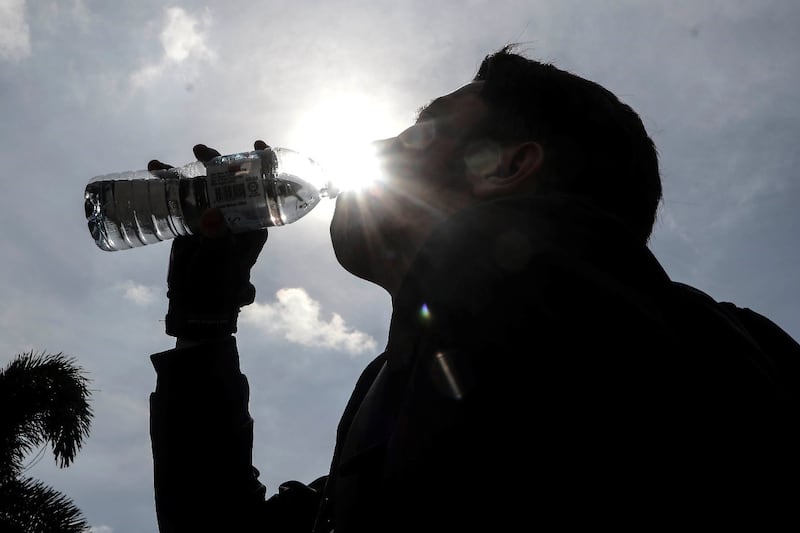Surizan Romli has fallen well behind in planting her first rice crop of the year because a heat wave and dry spell have scorched Perlis, her home state, and other parts of Malaysia.
She and other farmers in the rice-growing belt of northern Peninsular Malaysia said they’re feeling the negative effects from above-normal temperatures and scarce rainfall driven by El Niño weather patterns, which meteorologists have observed during the current Southwest monsoon.
“We should have started planting in April, but in Padang Siding, Perlis, the majority of rice fields are not involved in irrigation supplied by the agricultural department, and we rely solely on rainwater,” Surizan, who works full-time as a teacher and part-time as a rice farmer, told BenarNews.
“We haven’t even started planting yet, and by now we should have been waiting for harvest. It has been delayed for two months. Normally, we have two seasons in a year, but with this situation, we can only have one season.”
The heat wave and dry spell have lasted weeks with no immediate let-up in sight, raising concerns about food production, water scarcity as well as the potential harm to people’s health in this Southeast Asian nation.
Although Malaysia is a tropical country, some districts have recorded unusually high temperatures during three consecutive days ranging from 35 to 37 degrees Celsius (95 to 98.6 degrees Fahrenheit), prompting authorities to issue health warnings.
“The hotter and drier weather experienced from June to October 2023 is directly attributed to the El Niño phenomenon,” Muhammad Helmi Abdullah, director-general of the Malaysian Meteorological Department (MET Malaysia), told BenarNews.
“Typically, El Niño conditions in Malaysia can elevate temperatures by approximately 1.0º C to 2.0º C compared to normal conditions.”
El Niño, a natural phenomenon caused by significant increases in sea surface temperatures recorded in the central and eastern Pacific Ocean, disrupts global wind patterns that affect weather in various regions worldwide including Southeast Asia, according to experts.
In May, Petteri Taalas, secretary-general of the World Meteorological Organization (WMO), warned that this global weather event would have far-reaching repercussions for health, food security, water management and the environment.
Lost income
Farmers in Perlis and Kedah, Malaysia’s most productive rice-growing states, are among those hit hardest during the heat wave.
Ayuni Amil, another rice farmer from Perlis, said she had seen a huge reduction in income as a result.
“We have lost about 3,000 ringgit (U.S. $655) because we missed one season. The harvested yield should have been used to fund my children’s school supplies,” she told BenarNews.
Because of the El Niño effect, Ayuni said her family would have to wait until August before they could plant again – but only if the weather improves and the rains come.
“Then, another six months before the paddy is ready for harvest. Which means, I will only get my next income next year,” she said.
There are more than 57,600 paddy farmers living in Perlis and Kedah, according to the Muda Agricultural Development Authority (MADA), a government agency serving both states.
In a statement issued on Friday, MADA said it was closely monitoring data from the Meteorological Department and keeping an eye on water levels at local dams. For the time being, the dams are holding enough water to irrigate the paddy fields under its jurisdiction, MADA said.
“As a precautionary measure, MADA will utilize the recycling pump station in order to save water from the dam beside the usage of mobile pumps. This method will help to reduce water losses during hot weather,” the agency said.

At the federal level, the National Water Services Commission said it was dealing with the weather crisis, such as by setting up a dedicated war room to monitor the water situation at dams and water treatment plants.
“This proactive measure aims to ensure early detection and preparedness for any severe water shortages. As of now, water levels in the dams remain relatively stable, with no significant drops anticipated in the coming month,” said the commission’s Charles Santiago.
Previously, media reports had indicated that two dams in Penang, another northern state, were approaching critical levels caused by the lack of rainfall in the catchment areas and the prolonged heat wave.
The extreme heat has also been linked to fatalities. In April, two children from Kelantan state, aged 19 months and 11 years old, died from heatstroke and dehydration, officials said.
“The extremely high temperatures can lead to a wide spectrum of heat-related illnesses, such as heat rash, heat cramps, heat syncope, heat exhaustion and heatstroke. Heatstroke, if not promptly treated, can result in permanent disability and death,” Rozita Hod, who heads the Department of Public Health Medicine at Universiti Kebangsaan Malaysia, told BenarNews.
Despite being accustomed to living in a hot country in the tropics, Malaysians must avoid prolonged exposure to the searing sun, she said.
